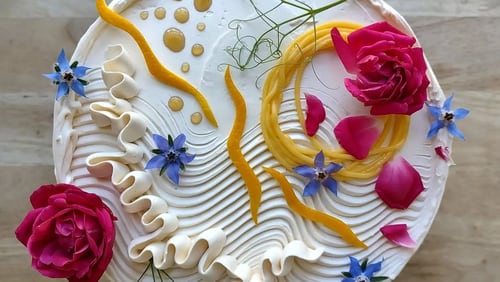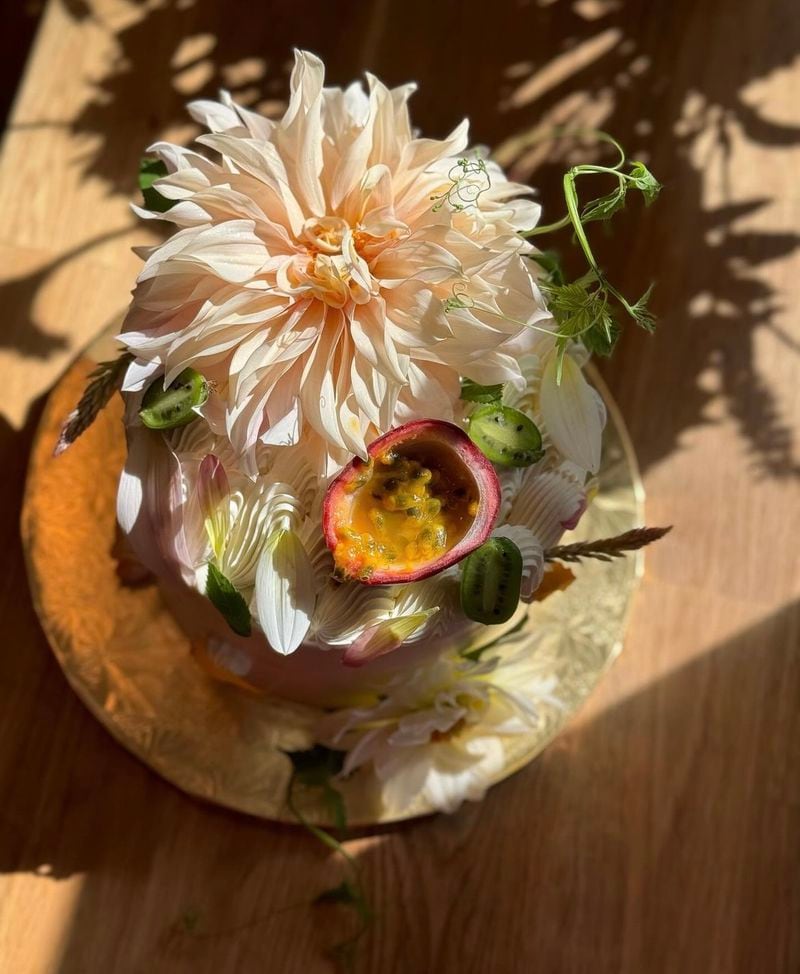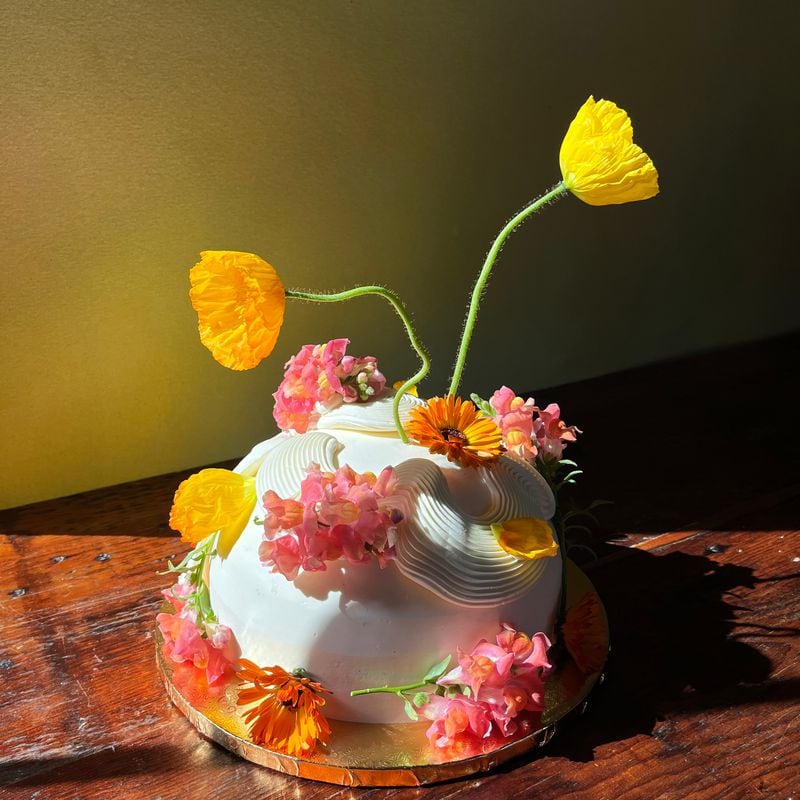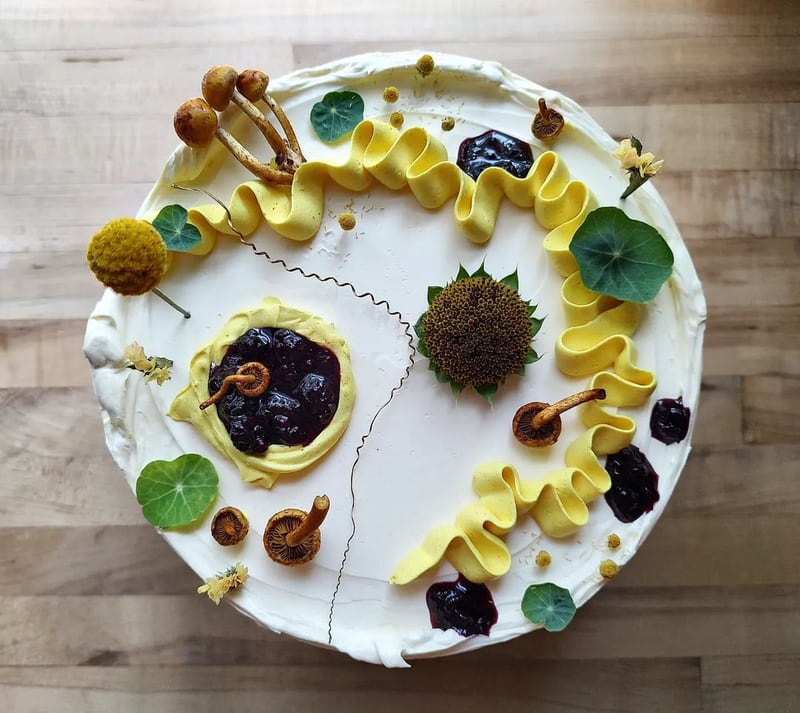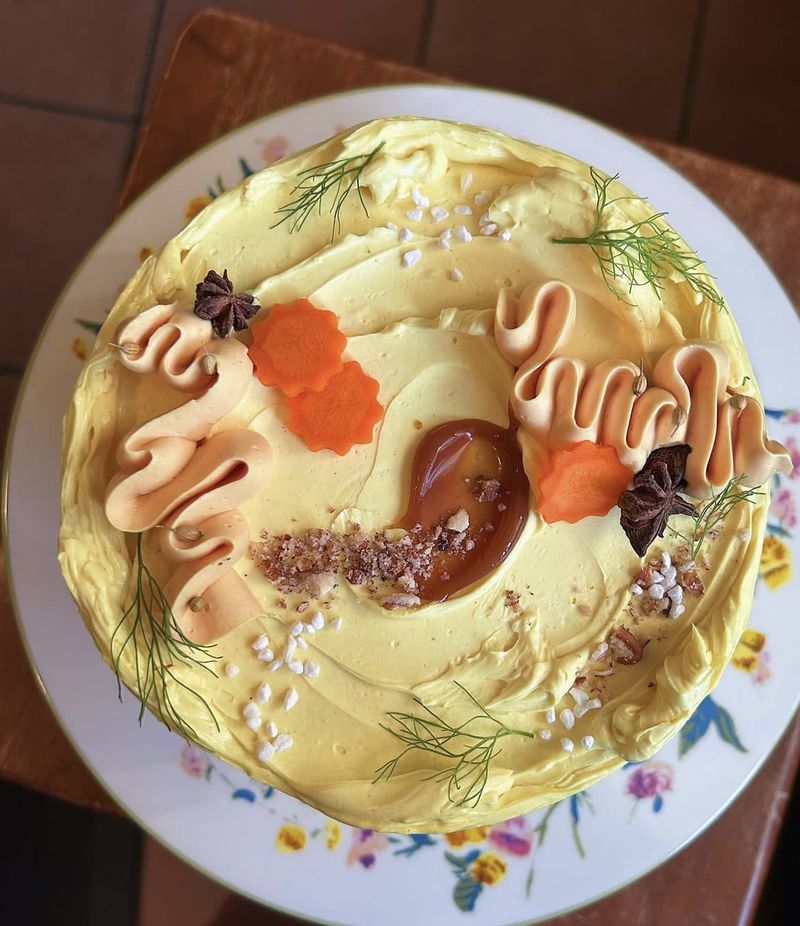The flowers at Floribunda Flower Farm in Stockbridge swayed gently in the breeze as two employees worked their way up and down the colorful rows, snipping stems and bundling them into piles. Some of the flowers would be sold at the Avondale Estates Farmers Market, while a select few would go to Teresa Finney, the Decatur baker behind At Heart Panadería.
Almost every week, Finney purchases a selection of flowers from Floribunda, most of which she’ll use to garnish her cakes. She is one of several bakers around the region who incorporate local flowers and other plants into their cake decorations.
“I never go into it thinking I know exactly what I want to do,” Finney said. “I like to let the flowers tell me how they want to go on a cake.”
This style of decoration doesn’t have a name, though Finney refers to hers as “garden cakes.” The edible artwork often features locally grown flowers, greenery, vegetable clippings, organic shapes and pools of jam or honey.
After Finney moved to Atlanta in 2015, she first baked as a hobby. When she lost her job in 2020, she began her own microbakery. At first, she mostly sold conchas and bread, but in 2022 she tried her hand at cakes, which proved popular.
Credit: Courtesy of Teresa Finney
Credit: Courtesy of Teresa Finney
Emily Shaw, owner of Athens microbakery Sun Cat Sweets, worked in various restaurant positions for about 10 years before she decided to strike out on her own just before the start of the pandemic. Over time, she built a customer base and a following on social media, which allowed her to observe decorating styles from other bakers.
“I think more people had time, more people were on the internet (and) there was more inspiration to be had,” Shaw said.
Social media is how she discovered Bayou Saint Cake, run by New Orleans baker Bronwen Wyatt.
Wyatt was at the forefront of this whimsical, abstract style, particularly when she popularized squiggles — an organic, blobby wave piped onto a cake. Wyatt suspects the popularity of the squiggle stems from it being an inexpensive technique that can be replicated with a plain piping tip, as opposed to more elaborate methods that incorporate intricate ruffles and lace-like designs.
She has worked as a pastry chef for about 14 years but was laid off from her restaurant job not long after the start of the pandemic, so she pivoted to selling her cakes on Instagram. She said her cakes are “nature-focused,” with ingredients “deeply rooted in the South,” such as local citrus, sweet potatoes, cane sugar and muscadines.
Credit: Courtesy of Bronwen Wyatt
Credit: Courtesy of Bronwen Wyatt
Calli Marie of Calli Marie Bakes, a baker and cafe owner in Jacksonville, Florida, has been using live flowers on her cakes for years, but she didn’t notice it gaining traction until around 2020.
“I think it’s more approachable ... just a different artistry than everyone is used to seeing,” she said. “It’s not a cake you get at the grocery store.”
Rebecka Rodgers of Geranium Club left her baking job in Los Angeles and moved back to San Antonio, Texas, about six months into the pandemic and started selling her cakes.
She’s passionate about working with regionally grown products, and her cakes have a distinctly abstract appearance, often featuring waves combed into the icing, pools of honey and jam, and plenty of squiggles and tendrils.
“I’m inspired by the natural world,” she said, “the chaos and beauty of plants and nature.”
She forages some of her decorations from the local landscape, but she also gets many ingredients from nearby farms. For example, she occasionally uses mushrooms from a friend’s farm in Houston on her cakes.
Credit: Courtesy of Rebecka Rodgers
Credit: Courtesy of Rebecka Rodgers
Rodgers said she never knows what the cake is going to look like “until all of the components and everything is in front of me, and it just kind of flows out.”
While a baker might need to sketch out some technical designs before decorating or baking, what drives this style is the spontaneity that comes from throwing an assortment of items on a cake, whether it’s something sweet, like candied fruit, or something you might not expect to find, like vines from a squash.
Decorating with plants and flowers, which wilt in a few days, makes the design feel like a “temporary thing,” Finney said. That prompts a person to sit down and enjoy the cake in that moment.
“Maybe people are just wanting something that is more real and more alive,” she said.
Credit: Courtesy of Emily Shaw
Credit: Courtesy of Emily Shaw
Making a garden cake at home
Finney suggested that home bakers looking to decorate their own garden cakes ensure that the flowers and other plants they want to use are edible.
Marie recommended buying local flowers, preferably from a farmer you’ve met, since most grocery store flowers are sprayed with chemicals.
If you are inserting a flower, she suggested covering the stem in food-grade wax or water tubes, to protect the inside of the cake. Otherwise, you can pipe a layer of frosting on the cake’s surface to place the flowers, then scrape it off when it’s time to eat.
In most cases, the bakers said, they remove the decorations before eating the cake.
“Cake is basically just a different medium of physical art,” Shaw said. “You just happen to eat it.”
Sign up for the AJC Food and Dining Newsletter
Read more stories like this by liking Atlanta Restaurant Scene on Facebook, following @ATLDiningNews on Twitter and @ajcdining on Instagram.
About the Author
